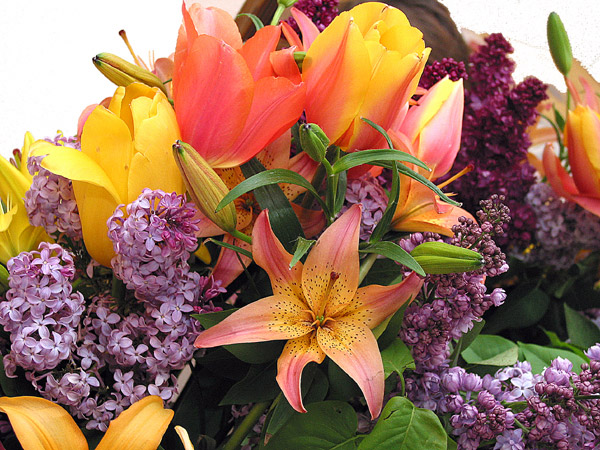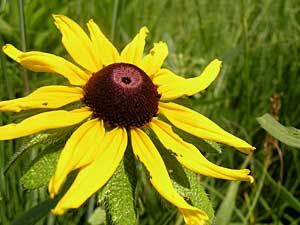When a farmer walked into Whole Foods wanting to sell a huge sack of morels, store employee Heather Hilleren watched a futile effort unfold.
The farmer didn’t have vendor credentials, and it would have taken two weeks to get them. By then, the freshly picked morels would have spoiled.
Category: Gardening
Garden Blogs
Including Adventures in my Urban Garden.
Farmers Market Flowers

Gotta love spring! [Dane County Farmers Market, on the square].
The Economics of Mulch
ST. FRANCIS: You’d better sit down, Lord. The Suburbanites have drawn a new circle, As soon as the leaves fall, they rake them into great piles and pay to have them hauled away.
GOD: No. What do they do to protect the shrub and tree roots in the winter and to keep the soil moist and loose?
ST. FRANCIS: After throwing away the leaves, they go out and buy something which they call mulch. They haul it home and spread it around in place of the leaves.
ST. FRANCIS They cut down trees and grind them up to make the mulch.
Sacramento Doubling Their Tree Canopy
Sacramento, Calif., claims more trees per capita than any other city in the world. It’s now embarking on a 40-year plan to double the city’s tree canopy. The potential benefits of urban forests include lower temperatures, improved air quality and — perhaps surprisingly– a calming effect on drivers.
Madison Leaf Collection Information
City of Madison Streets Department has a site with more information on local leaf collection.
World’s Largest Flower VR Scene
![]()
Peter Murphy shares a beautiful VR scene from the Botanic Gardens in Sydney where there was the rare flowering of the Titan Arum.
Healing Garden(s)
Susan Fornoff writes about Topher Delaney’s healing gardens:
Lavender flanks an antique French urn that serves as a fountain in one corner; lemons climb on the two antique French gates that delineate the garden’s three “rooms,” each with a terra-cotta colored bench designed by Philippe Starck.
There are tomatoes growing; bay, rosemary, a rose bush, nasturtiums, too. Aloe and opuntia elaborate on the medicinal theme, and jasmine surrounds the base of the visual centerpiece, an Italian fountain surrounded by a shelf of Haifa limestone.
“This is very beautiful stone, from Jerusalem,” Delaney says. “You see it in very lovely homes; you never see it in a hospital.” She looks around. “This is as good as it gets in the most fancy house you could ever find. This is as good as it gets.”
Smell the roses without maintenance?

Amy Chozick reviews the controversial use of shrub roses (9 million sold last year), cross bred to require little maintenance
he new varieties are controversial, with some long-stem-rose purists saying that even planting them is cheating. Still, shrub roses are now the fastest-growing segment of the rose market, with the nine million plants sold last year accounting for 30% of all rose sales — double the market share for shrub roses in 2002, according to the American Rose Society.
“These kinds of numbers are unheard of for roses,” says Keith Zary, director of research at wholesale rose distributor Conrad-Pyle, which sold 1.8 million of its “Knock Out” red-rose shrubs in 2003, up from 135,000 in 2000, the year it introduced the variety. Historically, a popular rose wouldn’t even hit the half-million mark, he says. At Jackson & Perkins, a nursery based in Medford, Ore., shrub-rose sales are up 6% this year, and the nursery’s multicolored “Garden Ease Rose Blankets” — $39.95 carpets of color that bloom into the fall — are now one of the company’s biggest sellers.
Backyard Prairie Gardens

Tim Post on the growing number of backyard prairie gardeners: